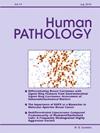肝细胞核因子4α作为子宫宫颈内膜腺癌及其前体的敏感标志物。
IF 2.7
2区 医学
Q2 PATHOLOGY
引用次数: 0
摘要
背景:肝细胞核因子(HNF)-4α是胃肠道肿瘤分化的标志物,但其在宫颈内膜肿瘤中的表达仍不清楚:我们旨在评估HNF4α表达作为宫颈内膜腺癌(ECAs)和坐位腺癌(AISs)标志物的效用,并建立一个最小面板,用于将它们与非肿瘤性宫颈内膜腺体病变和转移瘤区分开来:设计:对 323 份组织样本中的 HNF4α 表达进行免疫组化分析(阳性,H-score ≥ 10):57例宫颈内膜肿瘤(包括35例腺体肿瘤和22例鳞状肿瘤)、144例宫颈内膜非肿瘤性病变和122例其他器官肿瘤。用于区分宫颈内膜腺体肿瘤与非肿瘤性腺体和转移瘤的面板包括 HNF4α、p16、CDX2 和 SATB2;对染色进行了评估:结果:HNF4α在ECA和AIS(HPV依赖型和相关型)中有显著表达,但在非肿瘤性腺体和鳞状病变中没有表达(P < 0.05)。宫颈内膜 ECA 和 AIS 的免疫组化检测灵敏度和特异性分别为 77% 和 95%。单纯 AIS 的敏感性和特异性分别为 79% 和 94%,单纯 ECA 的敏感性和特异性分别为 75% 和 94%。HNF4α(+)或p16(+)或双阳性均可确定宫颈内膜腺体和鳞状肿瘤(灵敏度为96%;特异性为76%)。HNF4α(+)和SATB2(-)及CDX2(-)图谱提示ECA(灵敏度为69%;特异性为88%)。HNF4α(+)和SATB2(+)或CDX2(+)图谱提示胃肠道或生殖道腺癌(敏感性为81%;特异性为88%):HNF4α是一种很有前途的标记物,能准确检测与HPV无关或相关的ECA和AIS。HNF4α与p16、CDX2和SATB2的结合有望用于诊断面板。本文章由计算机程序翻译,如有差异,请以英文原文为准。

Hepatocyte nuclear factor 4α as a sensitive marker for uterine endocervical adenocarcinomas and their precursors
Context
Hepatocyte nuclear factor (HNF)-4α is a marker of gastrointestinal tumor differentiation; however, its expression in endocervical tumors remains unclear.
Objective
We aimed to assess the utility of HNF4α expression as a marker for endocervical adenocarcinomas (ECAs) and adenocarcinoma in situs (AISs), and to establish a minimal panel for distinguishing them from nonneoplastic endocervical glandular lesions and metastases.
Design
HNF4α expression was analyzed immunohistochemically (positive, H-score ≥10) in 323 tissue samples: 57 endocervical neoplasms including 35 glandular neoplasms and 22 squamous neoplasms, 144 nonneoplastic endocervical lesions, and 122 tumors from other organs. The panel for distinguishing endocervical glandular neoplasms from nonneoplastic glands and from metastases comprised HNF4α, p16, CDX2, and SATB2; staining was assessed.
Results
HNF4α was expressed significantly in ECAs and AISs, both HPV-independent and -associated types, but not in nonneoplastic glandular and squamous lesions (p < 0.05). The immunohistochemical detection sensitivity and specificity for endocervical ECA and AIS were 77% and 95%, respectively. For AIS alone, these were 79% and 94%, and for ECA alone, 75% and 94%, respectively. Either HNF4α(+) or p16(+) or double positive identified endocervical gland and squamous neoplasms (sensitivity, 96%; specificity, 76%). HNF4α(+) and SATB2(−) and CDX2(−) profiles suggested ECAs (sensitivity, 69%; specificity, 88%). HNF4α(+) and SATB2(+) or CDX2(+) profiles suggested adenocarcinomas of the gastrointestinal or genital tract (sensitivity, 81%; specificity, 88%).
Conclusions
HNF4α is a promising marker for detecting both HPV-independent and -associated ECAs and AIS with high accuracy. Its combination with p16, CDX2, and SATB2 has potential use in diagnostic panels.
求助全文
通过发布文献求助,成功后即可免费获取论文全文。
去求助
来源期刊

Human pathology
医学-病理学
CiteScore
5.30
自引率
6.10%
发文量
206
审稿时长
21 days
期刊介绍:
Human Pathology is designed to bring information of clinicopathologic significance to human disease to the laboratory and clinical physician. It presents information drawn from morphologic and clinical laboratory studies with direct relevance to the understanding of human diseases. Papers published concern morphologic and clinicopathologic observations, reviews of diseases, analyses of problems in pathology, significant collections of case material and advances in concepts or techniques of value in the analysis and diagnosis of disease. Theoretical and experimental pathology and molecular biology pertinent to human disease are included. This critical journal is well illustrated with exceptional reproductions of photomicrographs and microscopic anatomy.
 求助内容:
求助内容: 应助结果提醒方式:
应助结果提醒方式:


